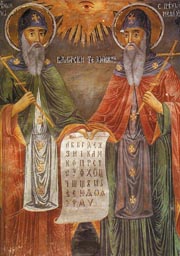THE FOUNDERS OF THE SLAVIC ALPHABET
The most significant event in the Bulgarian history, occurring in the first half of the ninth century, was the creation of the Slavic alphabet and the subsequent emergence of the Slavic literature.
In the course of three centuries, the Bulgarian state had achieved considerable social, economic and political progress. To satisfy its cultural and educational needs the Slavic part of the nation was in demand of an alphabet other than the Greek. In Bulgaria, such an alphabet was needed especially after Tzar Boris declared Christianity to be the official religion in the country in 885.
The Slavic alphabet was created by the famous Slavic educators - the brothers St. Cyril and Methodius. They were born in Salonika, the capital of Macedonia. St. Methodius was born in 825; and St. Cyril in 827, his original name was Constantine. Their father, Leon, was a nobleman and Byzantine magistrate.
St. Methodius, after studying law, was appointed governor of the Macedonian province but a few years later he abandoned the post and retired to the monastery of St. Basil on Olympus. St. Cyril studied with the best scholars, specializing in Greek literature, rhetoric, music and dialectics. He managed the office of the Secretary to the Patriarchate and Librarian at the Cathedral of St. Sophia in Constantinople. After that Cyril accepted a professorship at the famous University of Constantinople. Soon he entered priesthood and joined Methodius in the monastery. Being of Slavic descent, both of them spoke the old Slavic language fluently.
Cyril acknowledged that the Slavs could not understand the Divine Service and the Bible. So, the two brothers set themselves to inventing the necessary alphabet by taking letters from the Greek, Cryptic and Armenian alphabet. Scholars of the Old Slavic alphabet consider Cyril the author of the more difficult GLAGOLITZA script (862), contending that the CYRILLIC alphabet was invented by his disciple, St. Clement of Ohrid, some decades later. The Cyrillic alphabet derives from the Greek uncials of the ninth century, to which were added other letters that express Slavic sounds for which there was no equivalent in Greek. This less complicated alphabet has been and is still used by the Bulgarians, Russians, Serbs, Ukrainians and others in their liturgical and literary work. Although the Croats, Slovenes, Czechs, Slovaks and Poles are Slavs, they employ the Latin alphabet in both instances.
Having composed the alphabet, Cyril and Methodius began the translation of the Scriptures and the necessary religious books. The translations were spread not only in Bulgaria but throughout the whole Slavic world.
People known as Khazars had settled around the Black Sea in southern Russia. In 860, the Khazars petitioned Constantinople to send them Christian missionaries and the first to be sent there (860) were Cyril and Methodius. With the help of the newly invented alphabet, the Glagolitza, they succeeded in Christianizing all of the Khazars including their Khan (ruling prince).
Immediately after the Khazars mission, a delegation arrived (862) in Constantinople from Moravia (now part of Czechoslovakia). Rostislav (846-870), the ruler of Moravia - Bohemia, having established an independent kingdom had driven out the German influence and asked for Christian teachers and missionaries who could preach to his people in their Slavonic language. St. Cyril and Methodius were again selected for this job. Once in Moravia (863-867), they began translating more Scriptures and Liturgical books from Greek to Glagolitza. This activity aroused he German clergy of the neighboring states. Wearied by continued complaints against the Salonika brothers, the pope (Adrian II) interrupted their three years of missionary work by summoning them to Rome.
While in Rome, Cyril and Methodius were both consecrated as bishops. Amid the honors lavished upon them, Cyril fell ill and on February 14 869, passed away at the age of forty-two. He was buried in the lower Basilica of St. Clement’s Church in Rome.
After his brother’s death, St. Methodius returned to Moravia to continue his missionary work despite the enormous opposition against him. The German bishops succeeded in 871 in forcing Methodius to leave. Returning to Constantinople in 882 he continued working on the translation of the Bible. Exhausted physically after twenty-two years of missionary work among the Slavs, he died in 885 at the age of sixty.
Because of the continued persecution by the German bishops, the students and assistants of Cyril and Methodius in their missionary work in Moravia and Pannonia had been compelled to return to Bulgaria. In need of teachers and preachers in his civilizing mission, Tzar Boris First welcomed them with joy and gratification. The missionaries were more than two hundred in number. The most prominent of them were St. Clement of Ohrid (Macedonia), Naum, Gorasd, Angelarius and others.
From the book “THE BULGARIANS“
by Chris Anastasoff, M.A

